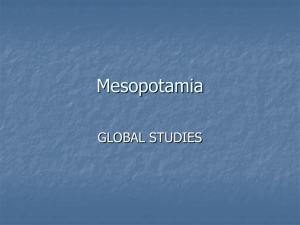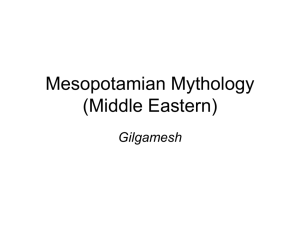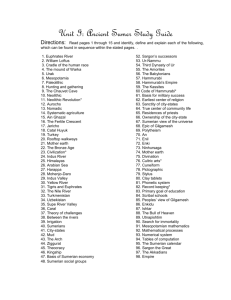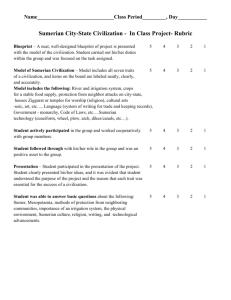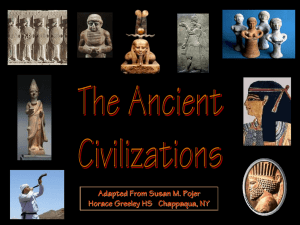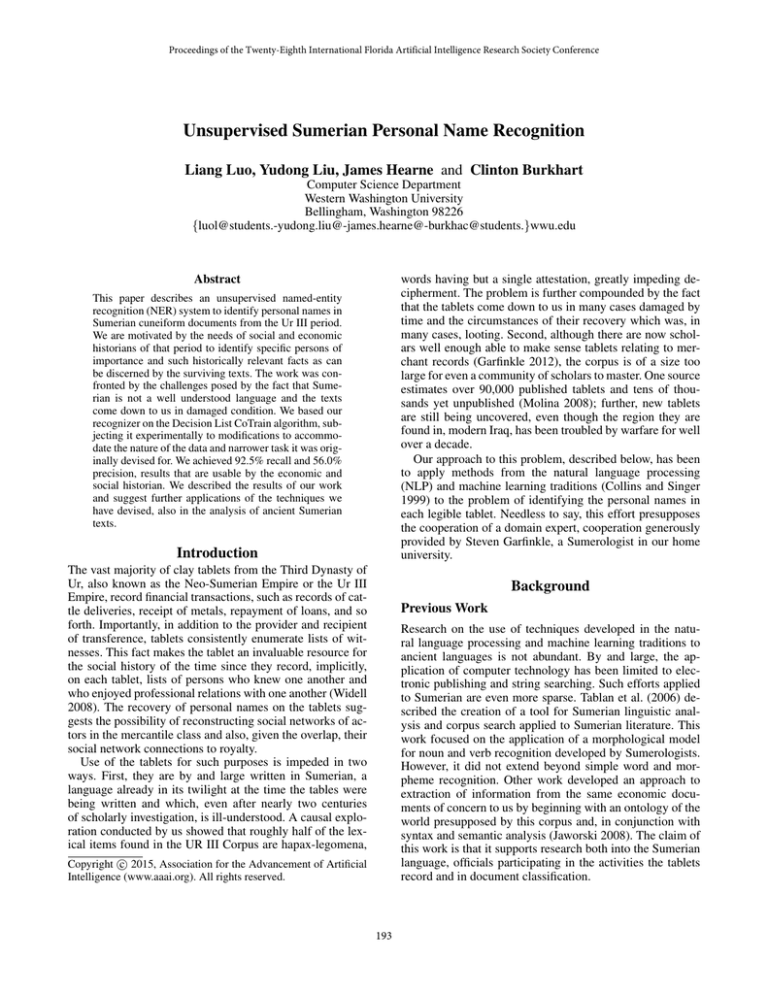
Proceedings of the Twenty-Eighth International Florida Artificial Intelligence Research Society Conference
Unsupervised Sumerian Personal Name Recognition
Liang Luo, Yudong Liu, James Hearne and Clinton Burkhart
Computer Science Department
Western Washington University
Bellingham, Washington 98226
{luol@students.-yudong.liu@-james.hearne@-burkhac@students.}wwu.edu
Abstract
words having but a single attestation, greatly impeding decipherment. The problem is further compounded by the fact
that the tablets come down to us in many cases damaged by
time and the circumstances of their recovery which was, in
many cases, looting. Second, although there are now scholars well enough able to make sense tablets relating to merchant records (Garfinkle 2012), the corpus is of a size too
large for even a community of scholars to master. One source
estimates over 90,000 published tablets and tens of thousands yet unpublished (Molina 2008); further, new tablets
are still being uncovered, even though the region they are
found in, modern Iraq, has been troubled by warfare for well
over a decade.
Our approach to this problem, described below, has been
to apply methods from the natural language processing
(NLP) and machine learning traditions (Collins and Singer
1999) to the problem of identifying the personal names in
each legible tablet. Needless to say, this effort presupposes
the cooperation of a domain expert, cooperation generously
provided by Steven Garfinkle, a Sumerologist in our home
university.
This paper describes an unsupervised named-entity
recognition (NER) system to identify personal names in
Sumerian cuneiform documents from the Ur III period.
We are motivated by the needs of social and economic
historians of that period to identify specific persons of
importance and such historically relevant facts as can
be discerned by the surviving texts. The work was confronted by the challenges posed by the fact that Sumerian is not a well understood language and the texts
come down to us in damaged condition. We based our
recognizer on the Decision List CoTrain algorithm, subjecting it experimentally to modifications to accommodate the nature of the data and narrower task it was originally devised for. We achieved 92.5% recall and 56.0%
precision, results that are usable by the economic and
social historian. We described the results of our work
and suggest further applications of the techniques we
have devised, also in the analysis of ancient Sumerian
texts.
Introduction
The vast majority of clay tablets from the Third Dynasty of
Ur, also known as the Neo-Sumerian Empire or the Ur III
Empire, record financial transactions, such as records of cattle deliveries, receipt of metals, repayment of loans, and so
forth. Importantly, in addition to the provider and recipient
of transference, tablets consistently enumerate lists of witnesses. This fact makes the tablet an invaluable resource for
the social history of the time since they record, implicitly,
on each tablet, lists of persons who knew one another and
who enjoyed professional relations with one another (Widell
2008). The recovery of personal names on the tablets suggests the possibility of reconstructing social networks of actors in the mercantile class and also, given the overlap, their
social network connections to royalty.
Use of the tablets for such purposes is impeded in two
ways. First, they are by and large written in Sumerian, a
language already in its twilight at the time the tables were
being written and which, even after nearly two centuries
of scholarly investigation, is ill-understood. A causal exploration conducted by us showed that roughly half of the lexical items found in the UR III Corpus are hapax-legomena,
Background
Previous Work
Research on the use of techniques developed in the natural language processing and machine learning traditions to
ancient languages is not abundant. By and large, the application of computer technology has been limited to electronic publishing and string searching. Such efforts applied
to Sumerian are even more sparse. Tablan et al. (2006) described the creation of a tool for Sumerian linguistic analysis and corpus search applied to Sumerian literature. This
work focused on the application of a morphological model
for noun and verb recognition developed by Sumerologists.
However, it did not extend beyond simple word and morpheme recognition. Other work developed an approach to
extraction of information from the same economic documents of concern to us by beginning with an ontology of the
world presupposed by this corpus and, in conjunction with
syntax and semantic analysis (Jaworski 2008). The claim of
this work is that it supports research both into the Sumerian
language, officials participating in the activities the tablets
record and in document classification.
c 2015, Association for the Advancement of Artificial
Copyright Intelligence (www.aaai.org). All rights reserved.
193
Figure 1: An example of a transliterated tablet with an ID of P100079.
Available Data
eration format used by CDLI. However, signs rendered in
uppercase occur frequently and denote a number of special
circumstances, most commonly, that the phonetic equivalent of the sign is unknown. With respect to our system, the
presence of uppercase signs is rarely problematic as long as
the spelling and casing is consistently attested in the corpus. This consistency is provided by the lemmatization required of Sumerologists in order to submit initial transliterations (Foxvog 2014).
Royal epithets notwithstanding, Sumerian personal names
are exclusively comprised of a single word, almost always
consisting of at least two signs. In cases where disambiguation is required, a patronymic may added (for example, szuesz4-tar2 dumu zu-zu, “Su-Estar, son of Zuzu”). This disambiguation is frequent in practice due to the relatively shallow
pool of personal names used (Limet 1960).
There are two main Sumerian tablet databases:
the
cuneiform
Digital
Library
Initiative
(CDLI,
http://cdli.ucla.edu/)
and
the
Database
of
Neo-Sumerian
Texts
(BDTNS,
http://bdtns.filol.csic.ed/). CDLI is a
project that concentrates on electronic documentation of
ancient cuneiform, consisting of cuneiform texts, images,
transliterations and glossaries of 3500 years of human
history. It is managed by UCLA, USA and the Max Planck
Institution for the History of Science, Berlin. BDTNS is
a database that manages more than 95,300 administrative
Sumerian cuneiform tablets during the Neo-Sumerian
period. In this project, we make use of the CDLI repository
because its restriction to the ASCII character set is more
convenient than the UTF-8 encoding used by BDTNS.
Of the CDLI repository we use the 53,146 tablets having
lemmata.
Lemmata
62.1% of the tables in the CDLI corpus are accompanied
by annotations, dubbed “lemmata” which provide, stemification, translation and categorization of linguistic elements
within a line. Thus, the example given in Figure 2 gives a
line of text followed by its lemmatization, indicated with a
line-initial “#.” In this example, the lemmatization indicates
Data
Words and Signs
Although the texts we are investigating were originally
written in cuneiform script, scholars have traditionally
worked with transliterations using the English alphabet. Homophony, which is very common in cuneiform, is handled
by numerical subscripts, i.e., “gu,” “gu2 ” and “gu3 ” refer to distinct signs with the same sound value. Sumeriologists have developed a system of in-text annotations important to the application of NLP techniques. Figure 1 shows
the tablet with an id of P100079 from CDLI repository
(http://cdli.ucla.edu/). The original cuneiform
script is on the left; the transliteration is in the middle and
the modern English translation is on the right.
Sumerian written in cuneiform script does not have the
concept of upper- or lowercase, and as a result, in monolingual contexts, the typical step of case normalization is not
necessary as all text is rendered in lowercase in the translit-
Figure 2: A lemmatized transliteration.
that the word “GAN2” derives from the Sumerian stem “iku”
and is understood to mean “unit.” Similarly, “ur-{gesz}gigir” is a personal name; “nu-banda3” with the Sumerian
stem “nubanda” means “overseer”, a common profession in
Sumerian society; the word “gu4” with the Sumerian stem
“gud” means “ox.” Sometimes, when the function of a word
is uncertain, the lemmatization offers more than one cate-
194
Contextual Rules and Spelling Rules A contextual rule
specifies the context for a named-entity with the window
size of 1 or -1 (the right word or the left word). For example, according to the contextual rule “right context=TITLE
→ Person”, “nam-zi” is recognized as a personal name in
“nam-zi simug” given that “simug” is pre-tagged as “TITLE” (Smith) in the pre-processing phase.
A spelling rule specifies the spelling of a named-entity.
It is a sign sequence that can be either the full string of an
entity or is contained as a substring of the entity. For example, “contains(e2-kikken) → Person” is a spelling rule. By
applying the rule, the word “e2-kikken-ta” is recognized as
a personal name. With the spelling rule “full-string={d}enlil2 → Person”, the word “{d}en-lil2” is recognized as a
personal name.
gory. For example, lemma “GN|FN” indicates that the corresponding can be either a geographical name or the name
of a field (analogous to names such as “Potter’s Field” in
English).
Damaged Tablets
In CDLI corpus, some transliterations have “[” and “]” attaching to a sign. It indicates the sign is damaged. More
specifically, “[” indicates that the following sign is damaged
on the left edge, whereas “]” indicates the following sign
is damaged on the right edge (Sahala 2012). “[x]” indicates
that there is a sign that cannot be read due to the damage
on both edges and “[...]” indicates that there are several unreadable signs. This will be discussed in more detail in the
Annotation section.
Seed Rules As suggested by the language expert, the following three contextual rules are used as the seed rules for
our NER system:
Method
The NER system has three components: the preprocessing component, the Decision List Co-Train
(DL-CoTrain) (Collins and Singer 1999) component
and the post-processing component. We will discuss each
component in detail in the following.
left context=giri3 → Person
left context=kiszib3 → Person
left context=mu-DU → Person
The first rule indicates that a person is acting as an intermediary in the transaction. The second rule indicates that the
tablet was sealed by the named individual, and usually appears in administrative records. The last rule indicates that a
delivery was made to the named individual. Since these seed
rules have a high specificity to personal names, each of them
is given a strength of 0.99999.
Pre-processing
The transliteration standard used to represent the Sumerian corpus contains metacharacters specific to the many
different types of damage and modification that the original cuneiform tablets are subject to. Since these characters arouse unnecessary complications, we removed them as
noise. After removing these metacharacters, we also pre-tag
the corpus with a limited amount of pre-knowledge provided
by our language expert.
Algorithm The major task of the system is to learn a decision list to classify a word as a personal name. Initialized
with the 3 contextual seed rules, the decision list is applied
to label the training data to get spelling rules. In the next iteration, the newly obtained spelling rules are applied to label
the training data to get new contextual rules. In this alternating process, each iteration produces a new set of rules which
are ranked by their strength. In our system, the top 20 rules
with the highest strength are added to the decision list.
In (Collins and Singer 1999), the strength of a rule (x → y
where x is either a contextual feature or a spelling feature, and y is the label that belongs to one of the categories
{Person, Organization, Location}) is defined as follows:
Noise Removal When the Sumerologists transliterate the
tablets, they use metacharacters such as “[...]” and “#” to indicate damage to the text, and “!”, “?”, “*”, and “<...>” to
represent correction, querying or collation (Tinney and Robson 2014). For “[...]” and “<...>” cases, the Sumerologists
put their “best guess” within the brackets. For example, in
the word “[nu]-su”, the first sign was originally damaged
but restored by the Sumerologists as the “best guess”. Our
system removes the metacharacters as noise, and treats the
resulting text as if it were otherwise unannotated.
Annotation To utilize the pre-knowledge from the language experts and (Weibull 2004), we apply a tag set
of 13 tags to pre-annotate the corpus. The 13 tags in
the tag set {“GN”, “FN”, “TN”, “WN”, “MN”, “n”, “TITLE”, “UNIT”, “GOODS”, “OCCUPATION”, “YEAR”,
“MONTH”, “DAY”} represent geographical names, field
names, temple names, watercourse names, month names,
numbers, title names, unit names, trade goods names, occupation names and indicators for year, month and day, respectively.
strength =
Count(x, y) + α
Count(x) + kα
(1)
where Count(x, y) denotes the number of times a feature x
is seen with label y and Count(x) is the total occurrence of
feature x. α is a smoothing parameter and k is the number
of possible labels.
In our NER system, we first adopted the same formula, restricting the lable y to PN and hence Count(x, P N ) denotes
the number of times that a feature x and a personal name
(PN) appear together in training data, and Count(x) is the
total occurrence of feature x in training data. The value of α
is set to 0.1 and k is set to 2 experimentally. This practice
responded to the problem of finding rules which correctly
identify a single name. However, in subsequent iterations it
Decision List CoTrain (DL-CoTrain)
Our NER system is built over DL-CoTrain model (Collins
and Singer 1999), utilizing contextual and spelling rules to
create a decision list.
195
Results Table 1 shows the results of our DL-CoTrain system from 5 folds at the 90th iteration with the baseline system.
yielded no new names because it identified a context that occurred only once. We therefore experimentally settled on a
ranking criterion that made use of frequency of some feature
x, reverting to the original formula in the above Equation (2)
in the case of ties.
This algorithm, if iterated 150 cycles, produces a decision
list of over 2000 rules and approximately 17,000 personal
names in these Sumerian texts. More results are rehearsed
below.
System
Baseline
Post-Processing
Our domain expert suggested that two post-processing rules
could be applied to eliminate false positives. The application
of the following rules improved the performance by 0.5%.
• A word that starts with a number should not be a name.
• A word following the word “iti” (month indicator) should
not be a name.
DL-CoTrain
Fold 1
Fold 2
Fold 3
Fold 4
Fold 5
Average
Fold 1
Fold 2
Fold 3
Fold 4
Fold 5
Average
Precision
64.1%
64.2%
64.6%
65.4%
65.1%
64.6%
56.2%
55.8%
56.3%
56.3%
55.3%
56.0%
Recall
30.1%
29.6%
29.5%
30.1%
29.7%
29.8%
92.9%
92.1%
92.8%
92.4%
92.5%
92.5%
F-1
41.0%
40.5%
40.5%
41.2%
40.8%
40.8%
70.0%
69.5%
70.1%
70.0%
69.2%
69.8%
Table 1: The Precision, Recall and F-1 Measure of the baseline system and our DL-CoTrain system.
Experiments
We trained our NER system by using the algorithm described above and applied the rules from the decision list on
the testing data set. The result was compared with the result
from a baseline system on the same testing data set.
Table 1 shows that our NER system has an average Precision score of 56.0% and an average Recall score of 92.5%.
On the other hand, the baseline system has an average Precision score of 64.6% and an average Recall score of 29.8%.
The result shows that our NER system can recover 92.5%
of the personal names annotated in the lemmatization. The
56.0% Precision indicates that around 44% of the names
found by our NER system are not labeled as a personal
name in the lemmatization. However, preliminary investigation into these names by our language experts has suggested
that some of the false positives are, in fact names, are arise
from the very conservative policy followed by the authors
of the lemmata when working with damaged tablets. Our response to this fact can be found in (Liu et al. 2015).
Experimental Setup
We used a 5-fold cross-validation model to test our NER
system. In each fold, we randomly picked 85% of the tablets
from the corpus as our training set and the remaining 15%
of the tablets as the testing set. Our NER system spent 150
iterations to be trained. During each iteration, 20 new rules
were generated and added to the decision list. We use the
lemmatization as the gold standard data set in this experiment.
Experimental Results
More Experiments and Some Analysis
We ran a baseline system on the same testing set from each
fold to compare with the results from our NER system.
In order to see the impact of the number of iterations, and
the window size of the context to the result, we also ran the
following experiments.
Baseline System The baseline algorithm employs a naive
pattern-matching algorithm to attempt to identify personal
names based solely on sequences of words that appear commonly in the corpus (Brewer et al. 2014). Those 12 patterns
are: “dumu PN TITLE”, “PN szu ba-ti”, “ki PN”, “1(disz)
PN”, “n UNIT PN”, “kiszib3 PN”, “PN TITLE”, “PN i3dab5”, “n UNIT PN”, “giri3 PN”, “n PN” and “mu-DU PN”,
where “PN” indicates a personal name and the meanings of
other tags can be found in the Annotation Section.
The baseline system takes the transliterated text of each
tablet and populates a queue with every word in that tablet.
Each pattern in the collection is then tested against the words
at the beginning of the queue in decreasing order of pattern
length, since it is assumed that the longer patterns are most
specific. If, at any time, each non-personal-name word in
the pattern is at least a partial match with the corresponding
word at the beginning of the queue, the baseline marks the
word in the queue corresponding to the personal name in the
pattern as a personal name and no further patterns are tested
against the queue. This process is repeated until the queue is
emptied of words.
Figure 3: The changes on Precision, Recall and F-1 Measure
for 150 iterations.
Iterations The tendency of Precision, Recall and F-1
Measures with iterations is shown in Figure 3. Based on the
196
figure, both Precision and Recall become solid after the 90th
iteration. For this reason, we believe that the 90th iteration
is a good place to settle upon.
method can better the system performance. In fact, we have
been informed by the historian in our home university that
from his perspective, an NER system with a higher recall
and a lower precision is considered better than a system with
a lower recall, and a higher precision, because he will have
more room to do the verification on the result for the former
system, especially when the lemmatization was annotated by
a more critical and conservative approach. If given the opportunity, we also would like to see how the system works
when adopted to a different ancient language domain or to
Sumerian texts of different genres.
Tri-Gram and 4-Gram As described in Method Section,
when we induce contextual rule, we considered about bigrams case, whereas in the baseline system, we used some
tri-gram contextual patterns for matching. We, then ran two
more experiments in which the system induced only tri-gram
and 4-gram patterns.
System
Bi-Gram (90th )
Tri-Gram (90th )
4-Gram (90th )
Bi-Gram (150th )
Tri-Gram (150th )
4-Gram (150th )
Precision
55.8%
77.7%
77.2%
55.4%
72.6%
77.2%
Recall
92.1%
26.7%
26.5%
92.1%
31.0%
28.5%
F-1
69.5%
39.7%
39.5%
69.2%
43.4%
41.6%
Acknowledgments
The authors wishes to thank Steven Garfinkle from Department of History of Western Washington University for his
assistance and valuable input as a language expert in this
work.
References
Brewer, F.; Burkhart, C.; Houng, J.; Luo, L.; Riley, D.;
Toner, Brandon. Liu, Y.; and Hearne, J. 2014. A preliminary
study into named entity recognition in cuneiform tablets.
In The third Pacific Northwest Regional Natural Language
Processing Workshop, 1–3.
Collins, M., and Singer, Y. 1999. Unsupervised models
for named entity classification. In Proceedings of the Joint
SIGDAT Conference on Empirical Methods in Natural Language Processing and Very Large Corpora, 100–110.
Foxvog, D. 2014. An introduction to sumerian grammar.
Garfinkle, S. 2012. Entrepreneurs and Enterprise in Early
Mesopotamia: A Study of Three Archives from the Third Dynasty of Ur. Ithaca, NY USA: Cornell University Studies in
Assyriology and Sumerology (CUSAS).
Jaworski, W. 2008. Contents modeling of neo-sumerian ur
iii economic text corpus. In Proceedings of the 22nd International Conference on Computational Linguistics, 369–376.
Limet, H. 1960. L’Anthroponymie sumerienne dans les documents de la 3e dynastie d’Ur. Paris: Socit d’dition Les
Belles Lettres.
Liu, Y.; Burkhart, C.; Hearne, J.; and Luo, L. 2015. Enhancing sumerian lemmatization by unsupervised named-entity
recognition. In The 2015 Conference of the North American Chapter of the Association for Computational Linguistics - Human Language Technologies (NAACL HLT 2015)
May 31-June 5, 2015, Denver, Colorado, United States. The
Association for Computational Linguistics.
Molina, M. 2008. The corpus of neo-sumerian tablets: An
overview. In Garfinkle, S., and Cale Johnson, J., eds., The
Growth of an Early State in Mesopotamia: Studies in Ur
III Administration. Madrid: Consejo Superior de Investigationes Cientficas. 19–54.
Sahala, A. 2012. Notation in sumerian transliteration. Technical report, University of Helsinki.
Tablan, V.; Peters, W.; Maynard, D.; and Cunningham, H.
2006. Creating tools for morphological analysis of sumerian. In Proceedings of the Fifth International Conference
on Language Resources and Evaluation, 1762–1765.
Table 2: Precision, Recall and F-1 Measure for the bi-gram,
tri-gram and 4-gram models at the 90th and the 150th iteration.
As shown in Table 2, at the 90th iteration, the tri-gram
model and 4-gram model still maintained a high Precision
but failed to find as many names as the bi-gram model did.
At the 150th iteration, the Precision of the tri-gram model
decreased by 5.1% but the Recall increased by 4.3%; the
Precision of the 4-gram model maintained and the Recall increased by 2.0%. This result shows that, not unexpected, it
takes more iterations (i.e. longer time) to train a tri-gram
or 4-gram model. A method that combines these models
may improve both Precision and Recall. However, we do not
know when it is optimal to switch to tri-gram or 4-gram rule
induction.
Conclusions and Future Work
The immediate goal of this research is to develop an automated system to recognize Sumerian personal names from
the transliterations of the tablets. The recognition of personal names can greatly facilitate the recognition of dates
and events in Sumerian texts. Such information can further
help the historians to develop an environment for investigating Sumerian sociology. However, due to the availability of
more and more excavated tablets, and the lack of knowledge
of this language, extracting such information from Sumerian
texts is becoming a serious challenge faced by both the historians and the computer scientists.
In this paper, we adopted the unsupervised DL-CoTrain
algorithm for modern English processing to recognize
Sumerian personal names. Our experimental results showed
that the NER system built over the DL-CoTrain method,
with the minimal amount of prior knowledge, performs very
well in recovering names from Sumerian texts.
From the previous analysis, we would like to try a method
that also takes a larger contextual window into account, to
further improve the precision of the system. With the current annotation, we would hope that a supervised learning
197
Tinney, S., and Robson, E. 2014. Oracc: The open richly
annotated cuneiform corpus.
Weibull, N. 2004. A historical survey of number systems.
Technical report, Chalmers University of Technology.
Widell, M. 2008. The ur iii metal loans from ur. In Garfinkle,
S., and Cale Johnson, J., eds., The Growth of an Early State
in Mesopotamia: Studies in Ur III Administration. Madrid:
Consejo Superior de Investigationes Cientficas. 207–223.
198


